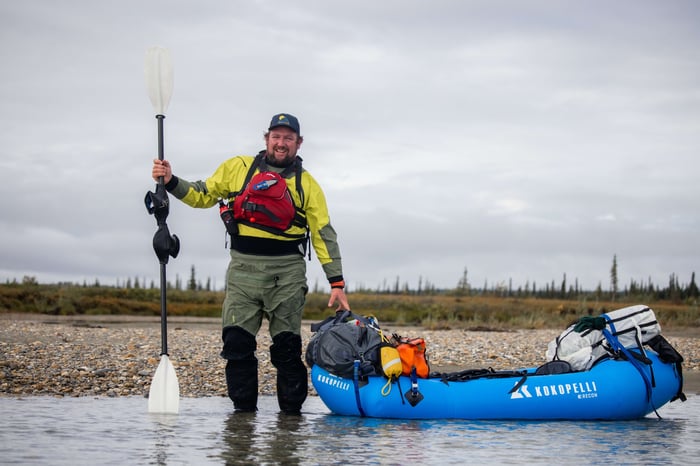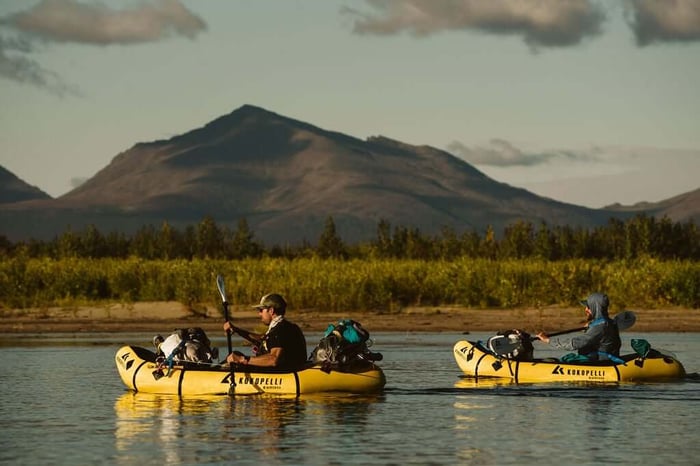A group of 5 adventure seekers set out to explore the unknowns and unexpected offerings of the Southern Brooks Range in Alaska. With very little beta and even less understanding of what to expect, this trip of a lifetime resulted in so many impactful experiences it’s hard to fully comprehend.
Ambler River within Gates of the Arctic National Park – Photo: Andy Austin
We soared Eastward over endless tundra before banking North through mountainous valleys and snow-covered peaks. After touching down on a gravel strip flanked by a rushing river, our bush pilot quickly helped unload our gear onto the river stone from his Cessna 180. We were about to dip our paddles into the chilly waters of the Ambler River within Gates of the Arctic National Park, the least visited of the 63 National Parks in the United States. We had planned this 6-day Arctic Circle packrafting trip for over seven months and it was finally go-time. Adrenaline was absolutely peaking.
Assembling the team’s gear on day #1 – Photo: Samuel Martin
Once all five paddlers situated our gear and inflated each of the packrafts, we launched into the crystal-clear glacial runoff of the Brooks Range and immediately felt the raw power of the river. No more than 200 feet into our 100+ mile trip, we had two team members capsize and were swimming in the frigid Arctic waters. As a team, we had immediately lost a paddle, a GoPro, an XtraTuf boot, and any other gear that wasn’t tightly strapped down. Mother Nature didn’t care about our months of meticulous planning, we would abide by her plans for how this trip would play out. We respectfully thanked the welcoming committee for the unapologetic smack of reality across our faces.
Wesley Maxwell getting further acquainted with Mother Nature – Photo: Andy Austin
After physically gathering what was left of the partially strapped down gear and emotionally gathering ourselves after the team’s yard sale start, we each smiled and reminded ourselves that this is the type of unknown experience we sought out in this remote and beautifully rugged section of Northwest Alaska. The adventure had officially started.
Settling into the groove - Photo: Samuel Martin
Over the next few days, the team found a groove. We learned to keep one eye on reading the ever-changing dynamics of the river, and another eye to appreciate the jaw-dropping expansiveness that this region offered. Day after day, we would slowly pour out of our tents and discuss plans for the day huddled over a semi-warm breakfast before packing up camp and reuniting with the restless river.
Photo: Samuel Martin
At best, our “plans” were loose guidelines that inevitably changed with each paddle stroke. We stopped often to take pictures and cast a few lines. This also served as an excuse to prepare another cup of hot coffee with a splash of bourbon and soak in the vastness of this corner of the earth. We’d share ridiculous stories of previous adventures and make up childish river nicknames for each other. Most frequently we would reiterate how appreciative we were to experience a place that very few others have seen with the naked eye. The environment was nothing short of breathtaking.
Adam Bratton chasing miles on the Kobuk River – Photo: Samuel Martin
After 60 miles on the beautiful Ambler River, we joined the Kobuk River. At the confluence of these two flowing ribbons of Arctic life was a tiny native fishing village fittingly named Ambler. The riverbanks were littered with dry racks bursting with fresh caught salmon organically aging in the open air. We, now “tourists”, inquisitively examined the first glimmer of civilization since our drop zone and a few village children rode up to us on their beat-up bicycles with their own inquisitive questions. Elders also approached as a greater respect quickly grew for the sustenance lifestyle, remoteness of this native village, and the beautiful ecosystem that was alive and well.
Fishing in Ambler, Alaska – Photo: Samuel Martin
The Kobuk River was an entirely different experience than the Ambler River. We had flowed downstream from sharp-peaked mountains and were now embracing rolling topography layered with endless spruce pines. Our raging river experience from day one was quite the opposite as we long longer had the powerful current at our backs. Mother Nature had served up 40 miles of flatwater and demoralizing headwind as an encore performance.
Yet another magical campsite - Photo: Samuel Martin
Adventures like this can easily beat you down both mentally and physically, but this entire experience was hitting differently. Day after day of 20+ miles of paddling would inevitably cause sore muscles and tired bodies, but morale remained at an all-time high. This was especially the case after crossing into Kobuk Valley National Park in the shadows of the impressive Jade Mountains. Each oxbow turn of the Kobuk River would lead to another stunning angle of this majestic range within the third least visited park in the National Park system. This backdrop perfectly bookended our time on the river as we approached our final camp with unobstructed views of the ridgeline, we’d been chasing for the last 30 miles.
Dead of night in Kobuk Valley National Park – Photo: Andy Austin
It’s perspective shifting to spend time in our natural environment and getting literally and figuratively drenched in its beauty. These experiences are difficult to fully comprehend and often harder to articulate. The sense of respect for Mother Nature is only amplified after an adventure of this magnitude. Recover coined the phrase “Be The Impact” to educate and inspire us to live and work for a sustainable tomorrow. After this experience, it’s clear that our environment can “Be The Impact” to educate and inspire us as well.
















